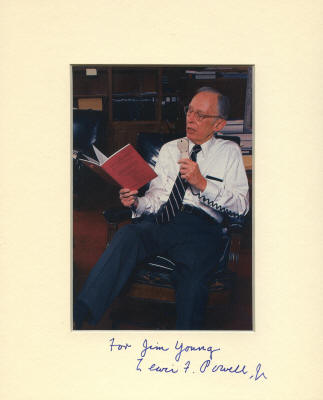707304
Lewis F. Powell, Jr.
Click on image for larger size
Lewis Franklin Powell, Jr., 1907–1998. Associate Justice, United States Supreme Court, 1972-1987. Extra fine photograph of Justice Powell boldly inscribed and signed on the mat For Jim Young / Lewis F. Powell, Jr.
Powell was one of the most influential Justices of the latter 20th Century. He was a moderate centrist who was generally seen as a swing vote. Because he sometimes provided the crucial fifth vote in 5-4 splits, he was in position to control the outcome of cases and the rationales on which the Supreme Court decided them.
For example, in the reverse discrimination case of Regents of the University of California v. Bakke, 438 U.S. 265 (1978), Powell navigated between competing four-Justice pluralities and, in a separate opinion of his own, created partial majorities for both but denied each its rationale. The University of California–Davis medical school had an affirmative action plan that, using a quota system, had denied a white student admission in favor of potentially less qualified minority students for whom the university reserved certain seats in the class. Using a lenient judicial test, Justice William J. Brennan, Jr., and three others would have upheld it against a constitutional equal protection attack. Justice John Paul Stevens and three others would have held the program illegal under the Civil Rights Act of 1964 without reaching the constitutional issue. Powell split the difference. He gave Brennan a nod by indicating that some affirmative action programs might be constitutional, but he insisted on evaluating them under a stricter test than the one Brennan advocated. Yet he also provided Stevens the fifth vote to strike down the plan, but he did so on the ground that it violated the equal protection provision of the constitution, not the Civil Rights Act of 1964. In the end, it was Powell who announced the judgment of the Court.
Powell, a Virginian who had been President of the American Bar Association, was a reluctant appointee to the Supreme Court. He removed himself from consideration in 1969 after he learned that President Richard M. Nixon was considering appointing him after the failed nomination of South Carolina's Clement Haynsworth. Three years later, when Nixon had two vacancies to fill, Powell again turned down the offer. Ultimately Nixon convinced Powell—a southern Democrat—that it was his duty to serve on the Supreme Court. The ABA rated him the “best person available,” and the Senate confirmed him by an 89-1 vote. On the day he was sworn in along with William H. Rehnquist, Nan Rehnquist asked his wife, Jo, “Isn’t this the most exciting day of your life?" Jo answered, “No, this is the worst day of my life. I am about to cry." Powell was not much happier. Given another 24 hours to consider the appointment, he told his sister, he would have refused it again.
Powell, who was 64 when he joined the Court, served more than 15 years before he retired in 1987. In retirement he taught and continued to sit by designation in cases before various United States Courts of Appeals.
Powell's career is thoroughly covered in the very readable 1994 biography Justice Lewis F. Powell, Jr. by John C. Jeffries, Jr., who served as one of Powell's law clerks in 1973. The fascinating story of his appointment is also recounted in the 2001 book The Rehnquist Choice by former Nixon counsel John W. Dean.
This is a matted, high-quality candid magazine photo showing Powell reading from a brief and dictating in his chambers at the Supreme Court. He has signed the mat boldly in blue. The autograph is extra fine.
Unframed.
_____________
This item has been sold, but
click here to see other
Supreme Court items
that we are offering.
|





